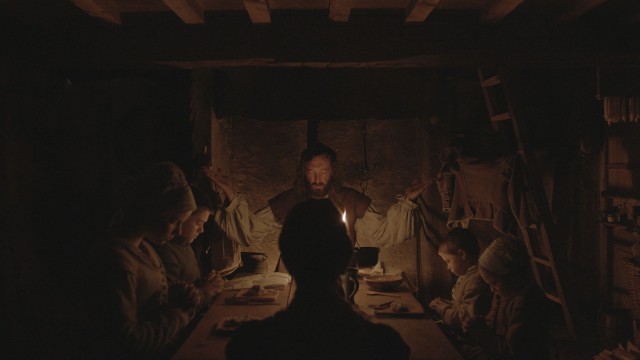The family in The Witch is doomed from the start when they’re banished from their puritan colony because William (Ralph Ineson), the father, thinks the religious order isn’t religious enough. They find an open field at the edge of the creepiest forest in the Northeast, and declare it home. Despite being a family of only 7 – containing two adults and 2 children over the age of 10 – the family is able to construct a barn and a 2-story cabin fairly quickly while planting corn and raising their animals and kin. It’s only when their babe is kidnapped from under the nose of eldest daughter Thomasin (Anya Taylor-Joy) that anybody realizes just how fucked they are. Burdened by a crop of corn gone rotten and a father who has absolutely no hunting skills, the family faces their imminent doom as winter sets in.
The Witch in The Witch is supposed to be a mystery. After problems repeatedly plague the family, they start turning on each other, eventually accusing each other of being cursed or a witch. Fearing for their life, paranoia and superstition override familial ties and basic humanity. The panicked paranoia might be frightening in what it says about humanity and belief structure, except The Witch is shown almost right off the bat. Shortly after the baby goes missing in the middle of Act One, Eggers indulges in a cut scene of The Witch killing the babe in a ritual bloodletting. By revealing the reality of The Witch, all of that paranoiac horror curdles into base family drama.
Writer-director Robert Eggers has a background in theater with a focus in Shakespeare, and it shows. These characters talk. They talk and talk. And then they talk some more. When you think they’re about done talking and finally about to get to the horror, they keep talking. This is less a piece of cinema than a filmed stage play. The dialogue is so plentiful, it hinders the intimacy required by horror movies. Further adding to the distance, all of the dialogue is supposedly fashioned from source material of the time period. Instead of creating an immersive experience, the hyperstylization creates a language barrier similar to A Clockwork Orange or Trainspotting. By molding the whole movie around the dialogue, Eggers created some horrible amalgam of a bad knock-off of The Crucible, and a Ti West no-burn film.
That isn’t to say that The Witch is terrible. Cinematographer Jarin Blaschke periodically strikes visual gold (even if his work is suppressed by the crappy blue-grey filter). Eggers’ attention to detail is stunning: the costumes are hand stitched, and the cabins feel hand-built. Eggers is playing with some interesting ideas about religious superstition overpowering common sense. He even gave some thought to the role witches play in horror, using The Witch as a metaphor for powerful women and male anxieties. Unfortunately, because Eggers is playing with paranoia and the line between reality and fairy tale, none of his metaphors are thoroughly explored, leaving the whole movie a mish-mosh of verbal diarrhea with half-assed strings left undeveloped. There is one shining star of the movie: Black Philip. That goat is amazing.

